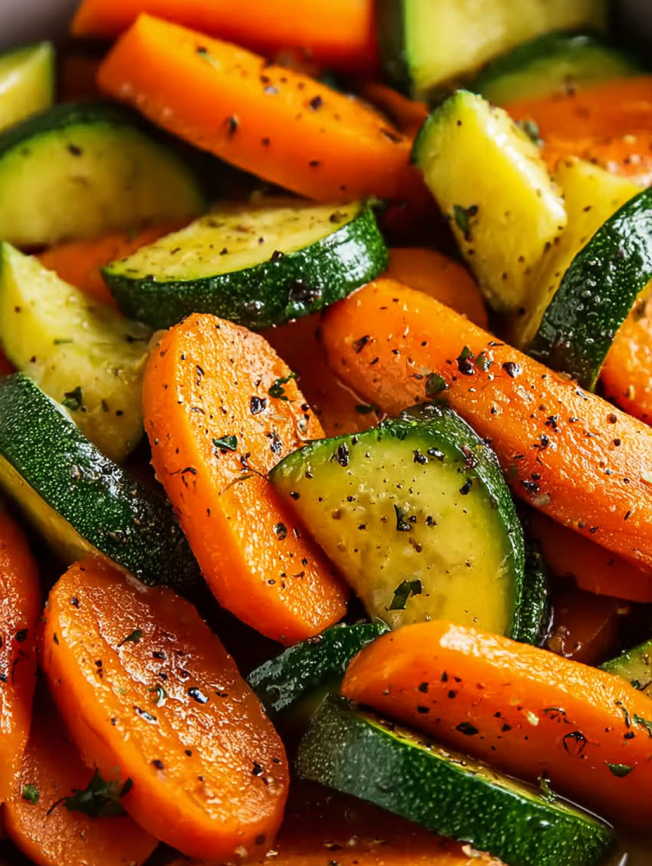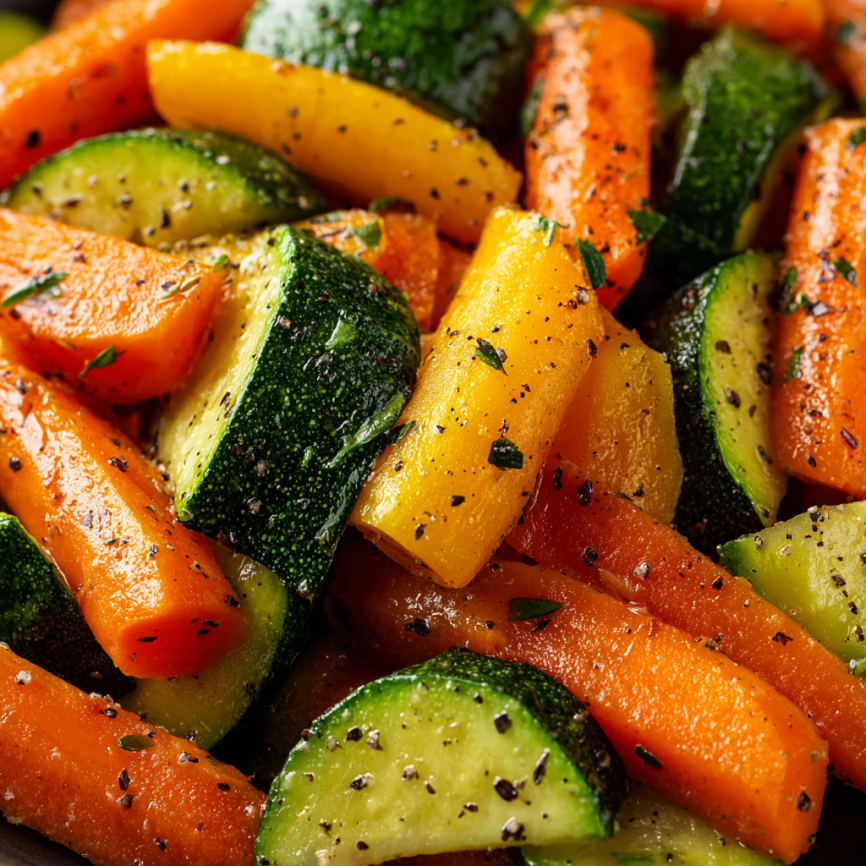Introduction: My Kitchen Game-Changer
There’s something magical about discovering a recipe that checks every box: simple, healthy, delicious, and versatile. For me, that recipe is sautéed carrots and zucchini. After years of overcomplicated side dishes that required endless prep and exotic ingredients, I stumbled upon this gem during a particularly hectic weeknight. What started as a desperate attempt to use up vegetables before they went bad has become my go-to side dish for everything from casual family dinners to dinner parties.
The beauty of this dish lies not just in its simplicity, but in how it transforms humble vegetables into something that feels restaurant-worthy. Moreover, it’s become my secret weapon for getting both kids and adults to eat their vegetables without complaint.
Why You’ll Fall in Love with This Recipe
Effortless Elegance
Unlike complicated vegetable gratins or elaborate roasted medleys, this recipe requires minimal skill and maximum flavor payoff. Furthermore, the cooking technique is foolproof – even beginners can master it on their first try.
Nutritional Powerhouse
Both carrots and zucchini pack impressive nutritional benefits. Carrots deliver beta-carotene for eye health and immune support, while zucchini provides vitamin C and potassium. Additionally, both vegetables are loaded with fiber and antioxidants that support overall wellness.
Diet-Friendly Champion
Whether you’re following paleo, keto, Whole30, or simply eating clean, this dish fits seamlessly into your meal plan. Best of all, it’s naturally gluten-free and dairy-free when prepared with coconut oil or olive oil.
Essential Ingredients
Main Components
- 4 medium carrots, sliced thinly – Choose firm, bright orange carrots for the best flavor
- 2 medium zucchinis, sliced into half-moons – Look for smaller zucchini as they tend to be less watery
- 2 tablespoons cooking fat – Ghee for richness, olive oil for Mediterranean flavor, or coconut oil for paleo cooking
- 2 garlic cloves, minced – Fresh garlic makes all the difference
- 1 tablespoon fresh parsley, chopped – The finishing touch that brightens everything up
- Sea salt and freshly ground black pepper – Quality seasonings elevate simple ingredients
Perfect Pairings
This versatile side complements grilled chicken, salmon fillets, pork tenderloin, or even quinoa bowls for vegetarian meals. Additionally, it works beautifully alongside roasted meats or as part of a mezze-style spread.
Step-by-Step Instructions
Preparation Phase
Begin by washing and trimming your vegetables. Slice carrots on the diagonal for an elegant presentation, ensuring uniform thickness for even cooking. Meanwhile, cut zucchini into half-moon shapes, keeping pieces roughly the same size as your carrot slices.
The Cooking Process
- Heat your chosen cooking fat in a large skillet over medium-high heat. The pan should be hot enough that a drop of water sizzles immediately.
- Add minced garlic and sauté for 30 seconds until fragrant. Be careful not to burn it, as burnt garlic turns bitter quickly.
- Introduce the carrots first since they require more cooking time. Sauté for 4-5 minutes, stirring occasionally to prevent sticking.
- Add zucchini to the pan and continue cooking for another 5-6 minutes. Stir gently to avoid breaking the vegetables while ensuring even browning.
- Season generously with sea salt and freshly ground black pepper, tasting as you go.
- Finish with fresh parsley just before serving to add color and freshness.

Serving Suggestions
Classic Presentations
Serve this dish family-style in a large serving bowl, allowing the vibrant colors to shine through. Alternatively, plate individual portions alongside your main course for a more formal presentation.
Creative Applications
Transform leftovers into a frittata filling, toss with pasta and parmesan, or add to grain bowls for extra nutrition. The possibilities are truly endless when you have this versatile base recipe.
Delicious Variations
Mediterranean Twist
Add a squeeze of fresh lemon juice and a sprinkle of oregano during the final minute of cooking. This variation pairs beautifully with grilled fish or lamb.
Asian-Inspired Version
Substitute sesame oil for the cooking fat and finish with a drizzle of soy sauce and sesame seeds. This works wonderfully with teriyaki chicken or salmon.
Herb Garden Special
Experiment with different fresh herbs like thyme, rosemary, or basil depending on your main dish. Each herb brings its own personality to the vegetables.
Spicy Kick Option
Add red pepper flakes with the garlic for those who enjoy heat. Start with a pinch and adjust to your preference.
Make-Ahead Tips
Prep Strategies
Vegetables can be sliced and stored in the refrigerator up to 2 days in advance. Keep carrots and zucchini in separate containers to maintain optimal freshness.
Batch Cooking
Double the recipe and store leftovers in the refrigerator for up to 4 days. Reheat gently in a skillet with a splash of water or enjoy cold in salads.
Freezing Guidelines
While fresh is always best, you can freeze the cooked vegetables for up to 2 months. However, the texture will be softer after thawing, making them perfect for soups or casseroles.
Pro Tips and Notes
Knife Skills Matter
Uniform slicing ensures even cooking and professional presentation. Take your time with the prep – it makes a noticeable difference in the final result.
Temperature Control
Medium-high heat is crucial for achieving that perfect balance of tender vegetables with slight caramelization. Too low, and they’ll steam; too high, and they’ll burn before cooking through.
Timing Is Everything
Watch your vegetables carefully during the last few minutes of cooking. The difference between perfectly tender and mushy happens quickly.

Frequently Asked Questions
Q: Can I use frozen vegetables for this recipe? A: While fresh vegetables are ideal, you can use frozen in a pinch. However, thaw and drain them thoroughly first, and reduce the cooking time since they’re partially cooked already. The texture won’t be quite as crisp, but the flavor will still be delicious.
Q: What’s the best way to cut the vegetables for even cooking? A: Aim for pieces that are roughly the same size – about ¼ inch thick for carrots and ½ inch thick for zucchini. Cutting on the diagonal not only looks more elegant but also creates more surface area for better caramelization.
Q: How can I prevent my zucchini from getting mushy? A: The key is not to overcook it and to avoid overcrowding the pan. If your skillet is too small, cook in batches. Also, adding zucchini after the carrots have had a head start prevents overcooking.
Q: Can I make this recipe oil-free? A: Absolutely! Use vegetable broth or water for sautéing instead of oil. You might need to add liquid gradually and stir more frequently to prevent sticking. The vegetables will be steamed rather than sautéed, but still delicious.
Q: What other vegetables work well with this cooking method? A: Bell peppers, yellow squash, snap peas, and green beans all work beautifully. Just adjust cooking times based on how tender each vegetable needs to be. Harder vegetables like peppers should go in with the carrots.
Q: How do I know when the vegetables are perfectly done? A: They should be tender when pierced with a fork but still have a slight bite to them. The edges should be lightly golden, and they should smell fragrant and caramelized.
Q: Can I prepare this dish for a crowd? A: Definitely! Use a large roasting pan in a 425°F oven instead of the stovetop. Toss everything together, spread in a single layer, and roast for 15-20 minutes, stirring halfway through.
Q: What’s the best way to reheat leftovers? A: Gently reheat in a skillet over medium heat with a splash of water or broth. This helps revive the vegetables without making them mushy. Avoid microwaving if possible, as it can make them soggy.
Prep Time: 10 minutes | Cooking Time: 10 minutes | Total Time: 20 minutes
Calories: 120 kcal per serving | Servings: 4

